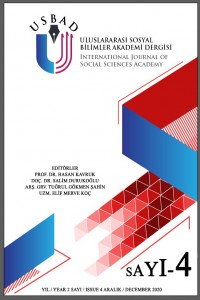Research Article
Year 2020,
Issue: 4, 957 - 967, 22.12.2020
Abstract
Hiyerarşik otorite ile bilgi otorite arasındaki ilişkiyi ortaya koyabilmek için, yönetimin en önemli konularından otorite, güç ve etkileme kavramlarının incelenmesinde fayda mütalaa edilmektedir. Ne yazık ki, otorite konusu dışında, güç, kuvvet ve etkileme konuları yönetim ve organizasyonun en ihmal edilmiş konuları arasındadır. Otorite konusu genellikle organizasyon konusu ile birlikte ele alınmaktadır. Oysa yönetim uygulaması tamamen güç kullanımı ile ilgilidir. Otorite ise güç kullanımının ancak bir çeşididir. Denilebilir ki, bilgi ve hiyerarşik otorite arasındaki temel fark organizasyonun yapısıdır. Bilgi çağında organizasyonlar karmaşıklaştıkça, yöneticilerin çözmek zorunda olduğu problemler de daha karmaşık bir hale gelmiştir. Bunun yanında yönetim süreçlerinde bilgi tabanlı parametreler artmıştır. Tek bir yöneticinin bütün problemlerin altından en optimum çözümle kalkması mümkün görülmemektedir. Zira artık bugün yöneticilerin sahip oldukları önemli güçlerden birisi ve belki de olmazsa olmazı da yasaların yanında bilgiden de bir otorite kaynağı olarak istifade etmek olmalıdır.
Keywords
References
- Akdemir, A. (2012). Effective Work Techniques. Ankara: Ankara Üniversitesi Yayınları. No: 560, No: 44.
- Arat, M. (2006). The Future of Management. İstanbul. Varlık Yayınları.
- Arıkan, S. (2002). Organizational Change and Leadership. Yüksek Lisans Tezi. Ankara: Hacettepe Ünivesitesi. Siyasal Bilimler Fakültesi.
- Bass, B. M. (2000). Handbook of Leadership. (3rd ed.). New York: Free Press
- Burns, J. M. (2008). Leadership. New York: Harper & Row.
- Carzo, R. & Yanouaz, J. (2007). Formal Organization, a Systems Approach. Michigan: The University of Michigan, 188.
- French, J. R. P. & Raven, B. (2008). The Bases of Social Power. in Cartwright, D. & Zander, A. Group Dynamics. New York: Harper & Row. 42.
- Güzelcik, E. (2009). Globalization and Changing Organization Image in Business. Istanbul: Sistem Yayınları.
- İlhan, E. (2013). Behavior in Business. Istanbul: Istanbul University Yayınları.
- Kaya, Ç. (2012). From Corridors of Civilization to Contemporary Management. Istanbul: Beta Yayınları.
- Petress, K. (2006). An Operational Definition of Class Participation
- Implications. College Student Journal 40(4), 821-823.
- Raven, B. H. (2004). "Power Six Bases of" Encyclopedia of Leadership. (Ed.). Thousand, Oaks. CA: SAGE. 1242-1249.
- Shetty, Y. K. (2008). Managerial Power and Organizational Effectiveness, a Contengency Analysis. Journal of Management Studies 15(2), 176.
- Şengöz, M. (2020a). Leadership Challenges in the Current Security Environment. Ankara: Astana Yayınları, 7-22.
- Şengöz, M. (2020b). The Framework of Military Leadership. Cambridge: Cambridge Scholars Publishing, 31-38.
- Şengöz, Murat (2020c) Yönetim Felsefesi: Gazi Paşa’nın Perspektifinden Aksiyolojik Liderlik Üzerine Mülahazalar. Ankara: Astana Yayınları. 72-82.
- Tutar, H. (2010). Business Management in Globalization Process. İstanbul: Hayat Yayınları.
- Weber, M., Henderson, A. M. & Parsons, T. (1947). The Theory of Social and Economic Organization. Oxford: Oxford University Press, 328.
Year 2020,
Issue: 4, 957 - 967, 22.12.2020
Abstract
In order to reveal the relationship between hierarchical authority and knowledge authority, the most important issues of management, authority, power and influence are examined in the examination of the concepts. Unfortunately, apart from the issue of authority, issues of power, power and influence are among the most neglected issues of management and organization. The subject of authority is generally dealt with in the context of the organization. However, the management application is completely related to the use of power. Authority is only one type of power use. It can be said that the main difference between knowledge and hierarchical authority is the structure of the organization. As organizations become more complex in the information age, the problems that managers have to solve have become more complex. In addition, knowledge-based parameters have increased in management processes. It is not possible for a single manager to solve all the problems under the most optimum solution. Because today, one of the important powers of the rulers, and perhaps the information as a source of authority should be to benefit from.
References
- Akdemir, A. (2012). Effective Work Techniques. Ankara: Ankara Üniversitesi Yayınları. No: 560, No: 44.
- Arat, M. (2006). The Future of Management. İstanbul. Varlık Yayınları.
- Arıkan, S. (2002). Organizational Change and Leadership. Yüksek Lisans Tezi. Ankara: Hacettepe Ünivesitesi. Siyasal Bilimler Fakültesi.
- Bass, B. M. (2000). Handbook of Leadership. (3rd ed.). New York: Free Press
- Burns, J. M. (2008). Leadership. New York: Harper & Row.
- Carzo, R. & Yanouaz, J. (2007). Formal Organization, a Systems Approach. Michigan: The University of Michigan, 188.
- French, J. R. P. & Raven, B. (2008). The Bases of Social Power. in Cartwright, D. & Zander, A. Group Dynamics. New York: Harper & Row. 42.
- Güzelcik, E. (2009). Globalization and Changing Organization Image in Business. Istanbul: Sistem Yayınları.
- İlhan, E. (2013). Behavior in Business. Istanbul: Istanbul University Yayınları.
- Kaya, Ç. (2012). From Corridors of Civilization to Contemporary Management. Istanbul: Beta Yayınları.
- Petress, K. (2006). An Operational Definition of Class Participation
- Implications. College Student Journal 40(4), 821-823.
- Raven, B. H. (2004). "Power Six Bases of" Encyclopedia of Leadership. (Ed.). Thousand, Oaks. CA: SAGE. 1242-1249.
- Shetty, Y. K. (2008). Managerial Power and Organizational Effectiveness, a Contengency Analysis. Journal of Management Studies 15(2), 176.
- Şengöz, M. (2020a). Leadership Challenges in the Current Security Environment. Ankara: Astana Yayınları, 7-22.
- Şengöz, M. (2020b). The Framework of Military Leadership. Cambridge: Cambridge Scholars Publishing, 31-38.
- Şengöz, Murat (2020c) Yönetim Felsefesi: Gazi Paşa’nın Perspektifinden Aksiyolojik Liderlik Üzerine Mülahazalar. Ankara: Astana Yayınları. 72-82.
- Tutar, H. (2010). Business Management in Globalization Process. İstanbul: Hayat Yayınları.
- Weber, M., Henderson, A. M. & Parsons, T. (1947). The Theory of Social and Economic Organization. Oxford: Oxford University Press, 328.
There are 19 citations in total.
Details
| Primary Language | English |
|---|---|
| Journal Section | Review Articles |
| Authors | |
| Publication Date | December 22, 2020 |
| Acceptance Date | July 23, 2020 |
| Published in Issue | Year 2020 Issue: 4 |


